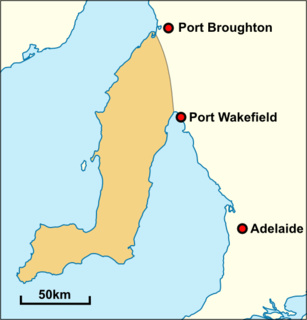The Diyari, alternatively transcribed as Dieri, is an Indigenous Australian group of the South Australian desert originating in and around the delta of Cooper Creek to the east of Lake Eyre.

The Narungga, otherwise known as the Narangga, are a group of Aboriginal Australians whose traditional lands are located throughout Yorke Peninsula, South Australia.

The Barngarla, formerly known as Parnkalla, are an Aboriginal people of the Port Lincoln, Whyalla and Port Augusta areas. The Barngarla are the traditional owners of much of Eyre Peninsula, South Australia, Australia.
The Erawirung people, also known as Yirau, Juju and other names, were an Aboriginal Australian people whose traditional territory was located in what is today the Riverland of South Australia. They consisted of sub-groups or clans, including Jeraruk, Rankbirit and Wilu, and have been referred to as Meru people, which was a larger grouping which could also include the Ngawait and Ngaiawang peoples.
The Barindji, also written Parrintyi, are an indigenous Australian people of the state of New South Wales. They are to be distinguished from the Paaruntyi, who spoke a similar language but whom they called the spitting people.
The Ngadjunmaia are an indigenous Australian people of Western Australia.
The Kaneang were an indigenous Noongar people of Western Australia.
The Mutumui were an indigenous Australian people of northern Queensland.
The Walmbaria are an indigenous Australian people of Cape York Peninsula in northern Queensland.
The Ngalia, or Ngalea, are an Aboriginal Australian people of the Western Desert cultural bloc resident in land extending from Western Australia to the west of South Australia. They are not to be confused with the Ngalia of the Northern Territory.

The Arabana, also known as the Ngarabana, are an indigenous Australian people of South Australia.
The Antakirinja, otherwise spelt Antakarinya, and alternatively spoken of as the Ngonde, are an indigenous Australian people of South Australia.
The Kuyani are an Aboriginal Australian people of the state of South Australia who speak the Kuyani language.
The Wailpi are an indigenous people of South Australia They are also known as the Adnyamathanha, which also refers to a larger group, though they speak a dialect of the Adnyamathanha language.
The Pilatapa were an Indigenous people of South Australia, now extinct.
The Ngameni are an indigenous Australian people of South Australia who once spoke the Ngameni language.
The Yawarrawarrka were an in Indigenous people of South Australia.

The Nauo (Nawu) were an Aboriginal Australian people of South Australia who spoke the Nauo language. They became extinct by the end of the nineteenth century.

The Wirangu are an Aboriginal Australian people of the Western coastal region of South Australia.
The Marulta were an indigenous Australian people of the state of Queensland, Australia.